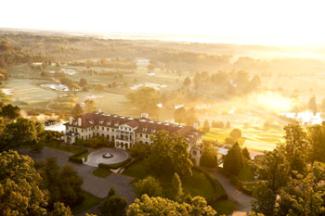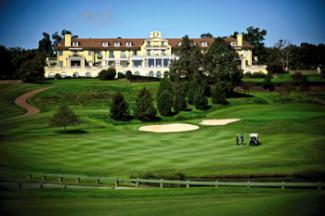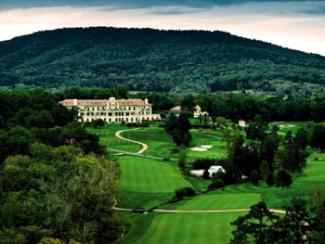Featured Golf News
Pete Dye Reworking Classic Course at Keswick Hall in Virginia
We just had a blast watching the best players in the world try to tame Pete Dye's TPC Sawgrass in Ponte Vedra, Fla., during last week's Players Championship. Dye's island-green 17th at the Stadium Course is perhaps is one of the top-five most notable - and photographed - holes in the world.

Aerial View of Keswick Hall
The 88-year-old Dye, who was born in Urbana, Ohio, is still at it. One of his latest projects, the reworking of the course at Keswick Hall near Charlottesville, Va., is set to be completed later this summer. Dye is not so much redesigning the course as enhancing it by constructing all-new tees (which will allow it to play between 5,000 and 7,000 yards), adding new sand to the bunkers and installing a new irrigation system, steps that he says will make the course play differently than in the past.
The refurbished Keswick Hall follows the same routing as the original 1948 Fred Findlay design, later renovated by Arnold Palmer in 1992. The course, which opened with Findlay's first nine, expanded to 18 holes in the mid-1950s. Palmer's efforts, which kept the majority of Findlay's design intact, included additional bunkers, contouring changes and new tees.
Dye is a member of the World Golf Hall of Fame as an architect (joining Donald Ross, Robert Trent Jones and Alister MacKenzie) and a fascinating figure of the game. Some may not realize that he was also a skilled player as a young man. Dye - who married another fine amateur, Alice Dye, and future design collaborator in 1950 - was runner-up in 1954 and '55 at the Indiana State Amateur, which he won in 1958. He also played in a number of USGA championships; his score at the 1957 U.S. Open was better than Jack Nicklaus and Palmer.

18th Hole at Keswick Hall Before Dye's Renovation
Dye can rightfully be called the father of modern golf course architects. P.B. Dye is one of his sons and Pete tutored Bill Coore, Tom Doak, John Harbottle, Butch Laporte, Tim Liddy, Scott Poole, David Postlewaite, Lee Schmidt, Keith Sparkman, Jim Urbina, Bobby Weed, Rod Whitman and Abe Wilson.
Dye's credits include the Ocean Course at Kiawah Island Resort, Harbour Town Golf Links at the Sea Pines Resort on Hilton Head, Crooked Stick in Carmel, Ind., and, of course, the Stadium Course at TPC Sawgrass.
His designs are known for small greens and the use of railroad ties to hold bunkers. Dye was influenced by a visit to Scotland in 1963, when he made a thorough study of classic courses. The Scottish use of pot bunkers, bulkheads constructed of wood, and diminutive greens contributed to many of his subsequent designs. Dye is a proponent of "target golf," and his layouts have been credited with returning short and mid-length par-4s to golf.
I had the opportunity to visit Keswick Hall and play the course before Dye's handiwork began. I'm pleased that Dye kept the original design pretty much intact, as the layout ambles over some of the prettiest property you will ever hit a golf ball along. The Virginia countryside is visually pleasing; the rolling land near Charlottesville is known far and wide as horse country. The course involves ancient oaks, grassy wetlands and mountain views, as well as lakes and streams.

Lush Virginia Countryside around Keswick Hall
The Inn and Keswick Hall are reminiscent of an Italian villa. It can be seen from a number of junctures on the golf course, most notably the 18th hole. As my group played its way back to the hotel on a warm afternoon and finally approached the final green the hotel seemingly glowed with a golden hue, its Italianate style stunningly Old World.
The course I played from the middle tees was solid and challenging yet very approachable, with only a few forced carries. The 10th hole, a 309-yard par-4, defines the term "risk/reward" Dye so enjoys incorporating. You can hit driver off an elevated tee to get close to the green, but it's a big chance because there's a wetlands and stream about 25 yards in front of the green. The safer play is to lay up before the creek for a shorter approach.
The drive on the penultimate hole, a 399-yard par-4, needs to be played down the left side of the fairway to make par more accessible. Dye's work won't change the par-4 18th as a superb finisher. The second shot requires a long-iron to reach the elevated green perched below the hotel. For those who can't get home, though, there's a deep gulley in front of the putting surface that can cause problems.

Panoramic Elegance from Keswick Hall
About Keswick Hall
There aren't many golf destinations where you can watch the running of the hounds, a tradition that has retained a strong foothold in the Virginia countryside. And at Keswick Hall, you can also play tennis, swim, bike, hike or do myriad other outdoor activities.
A little history lesson: The resort was originally a private home called "Villa Crawford," with fireplaces, ornate ceiling molding and a grand staircase. It was built in 1912 as a private residence for Mr. and Mrs. Robert B. Crawford. Robert Crawford, born in Alabama, had been a medical student at the University of Virginia, and his wife came from Providence, R.I., where her father was commodore of the Newport Yacht Club. Designed by prominent local architect Eugene Bradbury, the 8,000-square-foot, two-story, stucco-clad structure originally cost $100,000 to build.
After several subsequent owners led to a state of "senile ruin" with "touches of elegance" remaining, Villa Crawford was purchased in 1990 by Bernard Ashley, the widower of Laura Ashley, the famous textile designer who died in 1985. The new owner saw the potential for a world-class hotel after purchasing the home and 600-acre property for $5.5 million. He had the goal of turning it into a "country house" hotel, and felt strongly that Villa Crawford would be the heart of a truly outstanding property.
Ashley spent $25-million-plus expanding the number of guest rooms to 48, with each individually furnished and decorated. Laura Ashley's signature style was incorporated into the public spaces as well, and her husband placed many items in the hotel from his personal collection of antiques, including paintings, sideboards, cabinets, sculptures, busts and lithographs.
I can't wait to see what Dye has done to the course. I'm sure he took a very good layout and put some of his unique touches on it, leaving us with yet another of his gems.
For more information, visit www.keswick.com or call 434/979-3440.
John Torsiello is an editor/writer living in Connecticut. He has written extensively about all aspects of the golf industry for a number of national and regional publications. He is a regular contributor to “Golf Course Industry,” “Lawn and Landscape,” “Golfing” and “Fairway Living” magazines as well as various online publications. He has strong, ongoing relationships with industry professionals and has worked closely with course owners, architects, developers, course superintendents and general managers around the country. He has won a number of awards for his writing, including first place from the Turf and Ornamental Communicators Association for a piece that appeared in “Golf Course Industry” magazine.
Story Options
 |
Print this Story |
